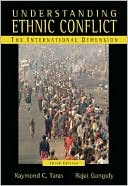

 |

|

Sold Out
Book Categories |
Preface: Nationalism, the War on Terror, and Conflict Resolution
PART I: ETHNIC CONFLICT AND INTERNATIONAL POLITICS: A CONCEPTUAL FRAMEWORK
1. ETHNIC CONFLICT ON THE WORLD STAGE
Introduction
Ethnic Group, Ethnic Nation, Ethnic Nationalism
Civic versus Ethnic Nationalism
National Self-determination in Practice
The Rise of Civic Nationalism
The Basis of Ethnic Identity
The Etiology of Ethnic Polarization and Conflict
Modernization and Ethnic Nationalism
Multiethnic States and Democratic (In)stability
Resource Competition and Ethnic Nationalism
Violent Ethnic Wars in the Post-Cold War Era
Ancient Hatreds and Ethnic Conflict
The Irredentist–Anti-Irredentist Paradigm
Insecurity, Fear, and Ethnic Conflict
Elites, Masses and Ethnic Conflict
Globalization and Ethnic Conflict
Goals of Ethnic Political Movements
The Staying Power of Ethnic Insurgency Movements
Conclusion
2. ETHNIC CONFLICT AND INTERNATIONAL NORMS
Introduction
International Norms Affecting Ethnosecession
The Doctrine of Sovereignty
Self-Determination and Ethnosecessionist Movements
The Moral Case for Secession
The Emerging Global Regime on Ethnic Minorities
Conclusion
3. ETHNIC CONFLICT AND INTERNATIONAL SECURITY
Introduction
Complex Humanitarian Emergencies
Internal Displacement and Refugees
Torture, Abuse, and Mass Rape
Child Soldiers
State Failure and Collapse
Ethnoterrorism
Guns-for-Drugs Syndrome
Partisan Intervention and Counter-Intervention in Ethnic Conflicts
Typology of External Partisan Intervention
Reasons for Partisan External Intervention
Characteristics of Partisan External Intervention
Constraints on Partisan External Intervention
Consequences of Partisan External Intervention
Conclusion
4. RESOLVING ETHNIC CONFLICTS THROUGH INTERNATIONAL INTERVENTION
Why Resolving Ethnic Conflicts Is Important
Ethnic Conflict Resolution by International Third Parties
Peacekeeping
Peacemaking
Peacebuilding
Ethnic Conflict Resolution by the United Nations
The United Nations as a Peacekeeper
The United Nations as a Peacemaker
The United Nations as a Peacebuilder
States as Third Parties in Ethnic Conflict Resolution
Major Powers and Ethnic Conflict Resolution
Ethnic Conflict Resolution by Third-World Regional Powers
Regional Organizations as Third Parties in Ethnic Conflict Resolution
International Nongovernmental Organizations as Third Parties in Ethnic Conflict Resolution
Conclusion
PART II: CASE STUDIES
5. NATIONALISM AND THE COLLAPSE OF AN EMPIRE: THE SOVIET UNION, RUSSIA, AND CHECHNYA
The Breakdown of Empires
Why Did Ethnic Conflict Occur?
Soviet Imperialism and Great Russian Nationalism
Democratization as a Source of Ethnic Conflict
The Conflict of Identities
Nationalist Mobilization in Post—Soviet Russia
The Core Ideas of Russian Nationalism
Russian Nationalists Resurgent
Russia’s New Minorities
Russia and Chechnya
Chechen Ethnosecessionism
International Reaction
Noninternationalization of the Chechen Conflict
Third-party Mediation in Chechnya
Conclusion
6. SEPARATIST MOVEMENTS IN CONSTITUTIONAL DEMOCRACIES: CANADA AND QUEBEC NATIONALISM
Introduction
Why Has Ethnic Conflict Occurred? Sources of Quebec Nationalism
British Colonization
Confederation
Economic Stagnation
Conscription Crises
Disputed Borders
Society in Transformation
The Quiet Revolution
Quebec’s Exclusion from the Canadian Constitution
The Failure to Bring Quebec Back in
The Growth of the Sovereignty Movement
The Canadian Supreme Court on Secession
Why Peaceful Secession Is Rare
International Reaction
Can a Constitutional Dispute Be Internationalized?
Is External Mediation Possible in Canada?
7. PROTRACTED ETHNIC WARS: THE TAMIL—SINHALESE CONFLICT IN SRI LANKA
Introduction
Why Did Ethnic Conflict Occur?
Internationalization of the Ethnic War
India’s Attempt at Conflict Resolution
The Ethnic Civil War in the 1990s
The Start of the Norway-Facilitated Peace Process
Peace Negotiations
Suspension of the Talks
Political Turmoil and its Impact on Peace Talks
Prospects for a Negotiated Peace
8. WEAKSTATES AND ETHNIC CONFLICT: SECESSIONISM AND STATE COLLAPSE IN AFRICA
Introduction
Weak States
Secessionism in Ethiopia
The Colonial Legacy
Pan—Africanism and Pan—Ethiopianism
Ethiopia’s Collapse, Eritrea’s Independence
Internationalization and External Mediation
Weak States, Politicized Identities in Central Africa
The Colonial Legacy and Hutu-Tutsi Rivalry
Internationalization and External Mediation
Keeping the State Strong: South Africa
Transition from Apartheid
Ethnicity, State-building, and the International System
Conclusion
9. WESTERN MILITARY INTERVENTION AND ETHNO-RELIGIOUS CONFLICTS: IRAQ, AFGHANISTAN, AND YUGOSLAVIA
Introduction
The U.S. Occupation of Iraq
Toppling a Dictator, Creating a Weak State
The Increased Salience of Ethnoreligious Cleavages
Ending Afghanistan’s Wars Through Intervention
Ethnicity, Warlords, and Internal Conflict
International Intervention and Peacekeeping after the Taliban
Wars in a Disintegrating Yugoslavia
International Prevarication
Third-party Intervention and Peacekeeping
Conclusion
10: U.S. FOREIGN POLICY AND NATIONALISM: TO INTERVENE OR NOT TO INTERVENE?
Studying Post-Cold War Policymaking
Rationales for U.S. Interventions
Promoting Liberal Internationalism
Preempting Security Threats
Activism to Promote Integration
The Backlash to U.S. Unilateralism
Conclusion
Login|Complaints|Blog|Games|Digital Media|Souls|Obituary|Contact Us|FAQ
CAN'T FIND WHAT YOU'RE LOOKING FOR? CLICK HERE!!! X
 You must be logged in to add to WishlistX
 This item is in your Wish ListX
 This item is in your CollectionUnderstanding Ethnic Conflict: The International Dimension
X
 This Item is in Your InventoryUnderstanding Ethnic Conflict: The International Dimension
X
 You must be logged in to review the productsX
 X
 X

Add Understanding Ethnic Conflict: The International Dimension, , Understanding Ethnic Conflict: The International Dimension to the inventory that you are selling on WonderClubX
 X

Add Understanding Ethnic Conflict: The International Dimension, , Understanding Ethnic Conflict: The International Dimension to your collection on WonderClub |